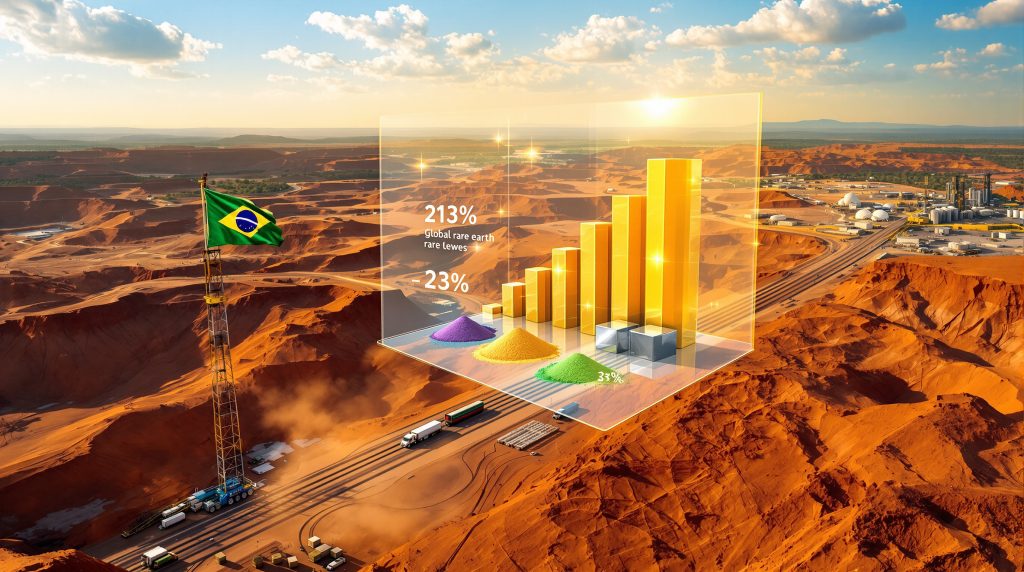Brazil's Strategic Position in Global Rare Earth Supply
Brazil is positioning itself as a critical alternative to China's rare earth element dominance, capitalising on substantial geological advantages and attracting increasing international investment. The South American nation's emergence as a strategic hub reflects both geological opportunities and geopolitical necessities driving Western supply chain diversification efforts.
Recent exploration activities demonstrate this growing momentum. Magnum Mining has initiated rare earth elements drilling in Brazil at its Azimuth Project, deploying auger rigs across a vast 900-square-kilometre area to test ionic clay rare earth targets. The company plans 333 auger holes totalling 1,665 metres at nominal five-metre depths, representing the scale of current exploration commitments.
This exploration surge reflects broader strategic interests in developing non-Chinese rare earth sources. The project areas benefit from favourable geological conditions, with Magnum's Azimuth Project located near some of Brazil's highest-grade niobium deposits, suggesting promising underlying geology for rare earth mineralisation.
Geological Advantages Driving Brazilian Rare Earth Development
Brazilian rare earth deposits offer distinct operational advantages through their ionic-clay formations, enabling more environmentally sustainable extraction methods compared to traditional hard-rock mining. These formations allow for leaching and separation processes that eliminate extensive blasting requirements and reduce chemical processing intensity.
Furthermore, these energy transition minerals are essential for modern technologies. The country's deposits contain strategically important heavy rare earth elements:
- Neodymium for permanent magnet applications
- Praseodymium for magnetic alloy production
- Dysprosium for high-temperature magnetic performance
- Terbium for specialised electronic applications
These elements are critical components in electric vehicle motors, wind turbine generators, and defence systems, aligning with Western industrial priorities and supply security objectives.
Technical Extraction Methods
The ionic-clay formations enable specialised extraction approaches that reduce environmental impact. Current drilling programmes utilise auger rig methodology specifically designed for clay horizon testing, allowing companies to assess mineralisation potential with minimal surface disturbance.
Areas showing promising initial results undergo subsequent grid-drilling programmes to quantify mineralisation scope and establish resource estimates. This multi-phase approach reduces exploration risk whilst systematically advancing project development.
Regional Distribution of Brazilian Rare Earth Activity
Brazilian rare earth exploration spans multiple states, each offering distinct advantages for different aspects of the supply chain. The geographic distribution reflects both geological favourability and infrastructure considerations essential for commercial development.
Minas Gerais represents the most advanced development stage, hosting Brazil's transition from exploration to commercial production. The state benefits from established mining infrastructure and proximity to processing facilities.
Goiás has emerged as a major exploration focus, with numerous high-priority targets identified through geophysical surveys. Moreover, the state's geological formations show particular promise for ionic-clay rare earth deposits.
Bahia is developing processing infrastructure capabilities, positioning itself as a potential refining hub for Brazilian rare earth production.
Infrastructure Development Requirements
Commercial rare earth production requires substantial infrastructure investment beyond extraction capabilities. Processing facilities must incorporate sophisticated separation technologies to achieve the purity levels demanded by end-use applications.
Transportation networks connecting mining areas to processing facilities and export terminals represent critical infrastructure components requiring coordinated development planning across multiple states.
Current Drilling Programs and Results
Active drilling campaigns are advancing resource definition across multiple Brazilian projects. The technical approaches vary based on deposit characteristics, with ionic-clay targets requiring different methodologies than carbonatite-hosted mineralisation.
Magnum Mining's Azimuth Project exemplifies current exploration intensity, with the company noting that no historical exploration has been conducted at their targets of interest, effectively creating a greenfields opportunity. This suggests significant unexplored potential across Brazilian rare earth districts.
In addition, proper drill results interpretation becomes crucial for understanding the economic potential of these discoveries. Companies are implementing systematic exploration approaches that follow industry innovation trends.
Multi-Phase Exploration Strategy
Companies are implementing systematic exploration approaches combining:
- Geophysical surveying to identify radiometric anomalies
- Auger drilling for initial clay horizon assessment
- Grid drilling for resource quantification
- Diamond drilling for carbonatite body evaluation
This comprehensive methodology accelerates resource definition whilst managing exploration costs and environmental considerations.
Investment Capital Flows Supporting Development
International investment is driving Brazilian rare earth development, reflecting Western strategic priorities for supply chain diversification. The investment patterns demonstrate both private sector interest and government backing for critical mineral security initiatives.
Recent funding activities include substantial private equity rounds specifically targeting Brazilian rare earth projects. Companies are securing multi-million dollar commitments for drilling programmes and infrastructure development, which aligns with broader investment strategy insights.
Private Investment Characteristics
Investment capital is flowing toward projects offering:
- Proven geological potential through initial drilling results
- Strategic element compositions aligned with Western demand
- Favourable extraction methodologies reducing environmental risks
- Infrastructure development potential supporting integrated operations
The investment focus reflects both commercial opportunity and strategic necessity for developing non-Chinese rare earth sources.
Global Context and Competitive Positioning
Brazilian rare earth projects are being developed specifically to integrate with Western supply chains, offering alternatives to Chinese-dominated processing networks. This strategic positioning enhances project economics whilst addressing geopolitical supply security concerns.
Consequently, the commercial viability of Brazilian operations depends on achieving competitive production costs whilst maintaining quality standards required by end-use applications. Processing capabilities that add value through separation and refining represent critical competitive advantages.
Supply Chain Integration Opportunities
Brazilian projects offer strategic advantages through:
- Geographical diversification from Asian supply sources
- Processing flexibility accommodating Western technical standards
- Political stability supporting long-term supply agreements
- Infrastructure potential enabling integrated value-chain development
Regulatory Framework and Development Support
Brazil's regulatory environment is adapting to support rare earth development whilst maintaining environmental and community standards. The permitting procedures reflect growing government recognition of rare earths as strategic minerals requiring supportive policy frameworks.
Environmental compliance requirements focus particularly on community engagement, especially regarding projects affecting rural settlements. These considerations require careful stakeholder management and environmental assessment processes.
Policy Development Trends
Brazilian mining policy is evolving to address rare earth development priorities through:
- Streamlined permitting procedures for strategic minerals
- Environmental assessment frameworks adapted to ionic-clay extraction
- Community engagement requirements ensuring stakeholder participation
- Infrastructure development support facilitating commercial operations
Development Challenges and Risk Factors
Brazilian rare earth development faces several operational and regulatory challenges requiring careful management. Rural communities and environmental concerns represent ongoing considerations for project advancement.
Infrastructure development requirements present substantial capital investment needs before commercial production can commence. Many exploration areas lack adequate transportation and processing facilities, requiring coordinated development planning.
Technical Processing Complexities
However, whilst ionic-clay deposits offer extraction advantages, achieving high-purity rare earth separation requires sophisticated processing technology and significant technical expertise. The complexity of separating individual rare earth elements to commercial specifications represents a substantial technical and capital challenge.
Processing facilities must accommodate varying feed compositions and maintain consistent product quality to meet end-user specifications across different applications.
Global Supply Chain Implications
Brazilian rare earth development offers Western nations strategic alternatives for critical mineral supply security. The projects under development could provide meaningful production capacity to supplement existing global sources whilst reducing dependence on single-supplier scenarios.
Market stability benefits from increased production diversity, potentially reducing price volatility associated with supply concentration. Brazilian operations could help stabilise rare earth markets through competitive supply alternatives.
Technology Transfer and Expertise Development
International investment in Brazilian rare earth projects facilitates technology transfer and expertise development, strengthening the country's long-term competitive position in critical minerals. These partnerships enable knowledge sharing across extraction, processing, and end-use applications.
Future Development Outlook
Current drilling programmes are targeting resource estimates and feasibility assessments within accelerated timeframes. The pace of exploration activity suggests commercial production decisions for advanced projects could emerge within the next several years.
Processing infrastructure development represents the next critical phase for Brazilian rare earth commercialisation. Planned refinery facilities will enable domestic value-addition, transforming Brazil from potential raw material supplier to integrated rare earth producer.
Strategic Partnership Evolution
Growing international investment suggests Brazil will become increasingly integrated into Western rare earth supply chains. This integration may include joint ventures, technology partnerships, and long-term supply agreements with major consuming nations.
The development trajectory indicates Brazil's potential emergence as a significant player in global rare earth elements drilling in Brazil supply, offering strategic alternatives that enhance supply security whilst creating commercial opportunities across the value chain.
Investment Disclaimer: This article discusses exploration-stage mining projects and commodity markets that involve substantial risks. Rare earth element projects face technical, regulatory, and market uncertainties that could significantly impact commercial outcomes. Investors should conduct thorough due diligence and consider professional financial advice before making investment decisions related to mining securities or commodity investments.
Want to Capitalise on Critical Mineral Discovery Opportunities?
Discovery Alert's proprietary Discovery IQ model delivers real-time notifications on significant ASX mineral discoveries, including critical elements like rare earths that are driving global supply chain transformation. With historic discoveries delivering exceptional returns, investors can explore Discovery Alert's dedicated discoveries page to understand the potential of major mineral finds, then begin their 30-day free trial to position themselves ahead of the market.




